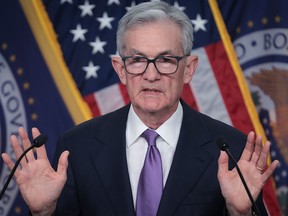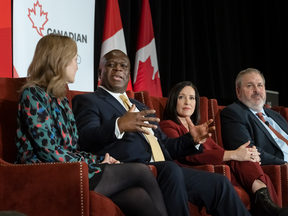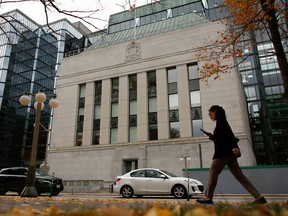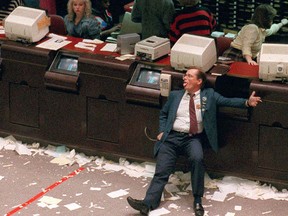Interest rate cuts predicted for next year likely won’t be enough, so this bond rally has legs
Article content
After sifting through the United States Federal Reserve’s forecasts and Jerome Powell’s cadence at the press conference, it seems the entire two-day Federal Open Market Committee meeting this week was spent discussing one thing and one thing only: how far and how fast to cut rates over the next two years.
So why did the Fed pull this mea culpa on Dec. 13? The answer is that the Fed is increasingly looking beyond the incoming and oft-revised economic data (with lower-than-normal response rates) and focused much more on what its business contacts are telling them. Nobody seems to believe a recession is plausible and yet the most recent Beige Book shows two-thirds of the U.S. is either flatlining or contracting outright (not one is accelerating). This is a greater share than we saw heading into the 2001 and 2008 recessions.
Advertisement 2
Article content
Article content
The Beige Book confirmed our suspicion that the third-quarter gross domestic product report was an aberration and likely borrowed heavily from future growth. Keep in mind that when it concluded that “economic activity slowed since the previous report,” that followed a statement that “most districts indicated little to no change in economic activity” and that was from six weeks ago. Going to “slowed” from “little or no change” is contraction when you look at the wording from a perspective of economic momentum.
Article content
That is what the Fed is responding to, and the rate cuts being predicted still likely won’t be enough. As for inflation, these five words from the Beige Book surely resonated: “Consumers showed more price sensitivity.” That says a lot right there.
As an aside, the Fed is calling for a tepid 3.8 per cent nominal GDP growth next year, but the stock market is pricing in 10 per cent growth in earnings per share. Both can’t be right. Given what the monetary policy lags imply and the withdrawal of fiscal stimulus means for real GDP growth for 2024, we are likely talking about real growth of no better than one per cent and quite possibly zero. Our models are tracking sub-one per cent headline and core inflation for next year. That means that even 3.8 per cent nominal growth is going to be very difficult to achieve. Think two per cent nominal. That is rare, but not unprecedented: we saw this in 1949, 1954, 195, 2008 and 2009. All recessions.
Article content
Advertisement 3
Article content
Listen to the bond market
Maybe the odds are 100 per cent instead of 90 per cent. The stock market doesn’t see it yet, but the bond market does, and it is the bond market that is the true leading indicator — practically every cycle in the past seven decades. Whether nominal growth is 3.8 per cent, two per cent or one per cent in the coming year, the bottom line is that even with six rate cuts priced in for 2024, that probably isn’t enough. Ergo, the bond market rally will still have legs.
The median dot plot change tells the tale: to 4.625 per cent for next year from the prior projection of 5.125 per cent. That is around 100 basis points of rate cuts for 2024 as the Fed follows the market’s lead … for a change. For 2025, the median call was taken lower to 3.625 per cent from 3.975 per cent. We had to rub our eyes when we saw that nine FOMC members are at 3.5 per cent or lower for 2025; and eight are at 2.75 per cent or lower for 2026. There is a lone wolf at 2.25 per cent for 2025 (is that Powell??) and that expands to three for 2026.
What we were given in the dot plots was just an appetizer. The meal is going to involve a near-complete reversal of this overly aggressive 2022-2023 tightening cycle. Powell came as close as he possibly could to signal that the Fed went too far this cycle. Once again, and for a different reason this time around, it is about saving face. To showcase just how much the Fed underestimates it will go in a cycle, consider that ahead of the tightening program in December 2021, it was calling for the funds rate to be 2.125 per cent as of today — and here we are, at 5.5 per cent.
Advertisement 4
Article content
Rate cycle has turned
We have also now learned the time dimension of “transitory.” Eighteen months. In the overall annals of economic history, that’s a blip. A zit. A blink of an eye. This ain’t the 1970s, folks. The big shift in the macro forecast was the slice in headline personal consumption expenditures (PCE) inflation to 2.8 per cent from 3.3 per cent for this year and a trimming to 2.4 per cent from 2.5 per cent in 2024. Core goes to 3.2 per cent this year from 3.7 per cent, and to 2.4 per cent next year from 2.5 per cent. And all this with the peak unemployment rate staying at 4.1 per cent, so there goes your “structural” inflation narrative out the window.
The thing is, the Fed always goes further than it thinks at the onset of both easing and tightening cycles. But the tightening cycle is in the rear-view mirror and the easing cycle is now staring us in the face. The market-based odds for a cut in March have soared to 67 per cent from 40 per cent. The gig is up; the rates cycle has turned.
Treasury yields are melting and it’s not over. Bonds are back, baby. The 10-year T-note yield has sliced below four per cent for the first time since July and having broken below its 200-day moving average, there is nothing but dead air all the way down to 3.5 per cent.
Advertisement 5
Article content
Mean-reverting the yield curve to the norm of the past 20 years (Bob Farrell’s Rule No. 1) says we are going to three per cent on the 10-year T-note, and, by extension, 3.5 per cent on the long bond (a good chunk of this predates the post-great financial crisis world of financial repression). That would imply total net positive returns of 15 per cent, and close to 20 per cent, respectively. Even the high-flying and overextended stock market may have trouble keeping up with that performance.
If there is a recession, the historical record tells us the Fed will have to cut 500 basis points. That sounds dire, but that is what the past has to offer. That would drag the 10-year yield down below two per cent and the 30-year bond to 2.5 per cent. Long-dated strips will deliver returns in this backdrop that will even make owners of bitcoin and the Magnificent Seven stocks blush.
If we don’t get a recession, just to get to the Fed’s ongoing estimate of a 2.5 per cent neutral level would require close to 300 basis points of cuts — just to withdraw the excessive restraint. Even here, the 10-year goes to three per cent and the long bond to 3.5 per cent. All roads lead to significantly positive Treasury market returns from here, and this train began to leave the station in late October. But it is not too late by a long shot, and it doesn’t matter if we actually get a recession or not because inflation is going to be heading a whole lot lower.
Advertisement 6
Article content
Related Stories
-

David Rosenberg: Get ready, the Fed has cause for a pause
-

The recession has been delayed, but it has not been derailed
-

David Rosenberg: Investors and economists are playing with fire
As an aside, while the Fed is shying away from predicting recession, the reality is that on the eve of every downturn in the past, the central bank didn’t see it when the proverbial banana was sitting in front of its face. The Fed is very likely at this point as much behind the growth and inflation curve today as it was in the other direction heading into 2022. Forgive me if I can’t hide my excitement.
David Rosenberg is founder and president of independent research firm Rosenberg Research & Associates Inc. To receive more of David Rosenberg’s insights and analysis, you can sign up for a complimentary, one-month trial on the Rosenberg Research website.
Article content
The Fed just woke up and smelled the recession
2023-12-14 18:11:26








